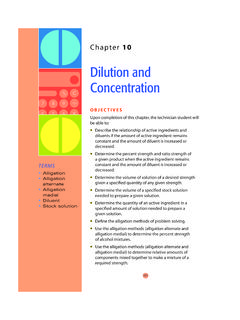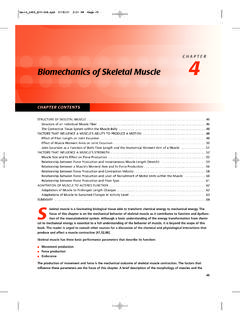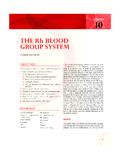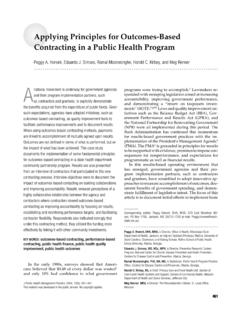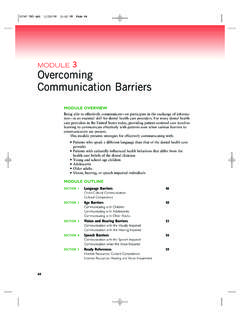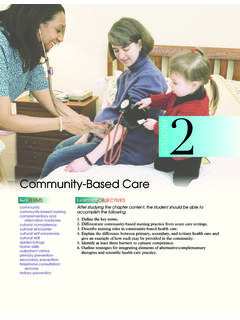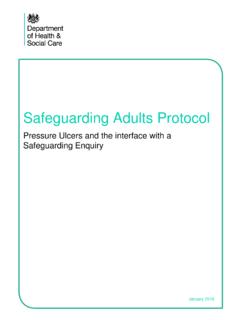Transcription of CHAPTER Preventing Pressure Ulcers and Assisting …
1 431 Many of your patients or residents will be at risk for devel-oping Pressure Ulcers . Preventing Pressure Ulcers is amajor concern of the nursing team because pressureulcers are painful, hard to treat, and potentially fatal. In this CHAPTER ,you will learn about your role in Preventing Pressure Ulcers . Pressureulcers are just one type of wound you may see when you are caring forpatients and residents. In this CHAPTER , you will also learn about howthe health care team cares for people with wounds and your role inassisting the nurse with wound Pressure Ulcers andAssisting With Wound CareCHAPTER19A nursing assistantmakes an occupiedbed.
2 Providing clean,wrinkle-free linens isjust one way thatnursing assistantshelp to prevent theirpatients or residentsfrom developingpressure nursing assistantmakes an occupiedbed. Providing clean,wrinkle-free linens isjust one way thatnursing assistantshelp to prevent theirpatients or residentsfrom developingpressure [431-445].qxd 01-07-2008 11:27 PM Page 431 Techbooks[PPG-Quark]432 UNIT 4 Basic Patient and Resident CarePressure ulcer a difficult-to-heal (and possibly even fatal)sore that forms when part of thebody presses against a surface(such as a mattress or chair) fora long period of time; alsoknown as Pressure sores anddecubitus ulcersPressure points bony areaswhere Pressure Ulcers are mostlikely to form; include the heels,ankles, knees, hips, toes,elbows, shoulder blades, ears,the back of the head, and alongthe spinePREVENTING Pressure ULCERSWhat will you learn?
3 When you are finished with this section, you will be able how Pressure Ulcers what conditions may increase a person s risk of devel-oping a Pressure why Preventing Pressure Ulcers is so changes in the skin that could be an early sign of apressure how nursing assistants help to prevent residents andpatients from developing Pressure special equipment that may be used to help preventpressure Ulcers . the words Pressure ulcerand Pressure points. How Pressure Ulcers formMany patients and residents are not able to change position easily due to weakness,disability, or illness. This inability to change position without help places the personat high risk for developing a Pressure ulcer .
4 Pressure Ulcers form when pressurepointspress against a mattress, chair, or other surface (Fig. 19-1). The pressuresqueezes the tissues in between the bone and the surface the person is lying or sittingon. As a result, blood flow to the tissues decreases. The tissues do not receive enoughnutrients and oxygen, and they die. The dead tissue peels off or breaks open, creat-ing an open sore or ulcer . Pressure Ulcers develop in four stages (Box 19-1).The longer a person remains in one position, the more likely that person is todevelop a Pressure ulcer . Many people with limited mobility also have other riskfactors for developing a Pressure ulcer , such as: Old skin of an older person is fragile and thin, with less blood flow.
5 Poor nutrition and lack of skin to remain healthy, good nutritionand adequate fluid intake are essential. contact with water, urine, feces, or sweat causes the epi-dermis to soften and break down (leading to skin breakdown ). Cardiovascular or respiratory with cardiovascular or respira-tory problems are at high risk for developing Pressure Ulcers because their med-ical condition prevents their tissues from receiving the full amount of oxygenand nutrients. Friction and shearing (rubbing) and shearing (pulling) forcescan injure the skin and lead to skin breakdown. Friction and shearing forcesare described in more detail in CHAPTER the Omnibus Budget Reconciliation Act (OBRA), one of the crite-ria used to evaluate the quality of care given by long-term care facilities thatLWBK098-3855G-C19[431-445].
6 Qxd 01-07-2008 11:27 PM Page 432 Techbooks[PPG-Quark] CHAPTER 19 Preventing Pressure Ulcers and Assisting With Wound Care433receive government funding is the health care team s ability to prevent residentsfrom getting Pressure Ulcers . The nurse is responsible for assessing each resident srisk for developing Pressure Ulcers when the resident is admitted to the long-termcare facility. The nurse also documents any existing Pressure Ulcers . OBRA expectsthe health care team to maintain or improve the person s condition. This meansthat the health care team works to heal existing Pressure Ulcers and takes measuresto prevent new Pressure Ulcers from forming.
7 Nursing assistants help the healthcare team to achieve these goals by carefully following the person s care plan. ShoulderHip (ischial tuberosity)Lower spine (sacral area)Back of headShoulderSpine (vertebrae)Lower spine (sacral area)Tailbone(coccyx)HeelCheekand earShoulderRibsHip (iliaccrest)Hip (greatertrochanter of femur)KneeAnkle(outside)Ankle(inside)Jaw ElbowBreastbone(sternum)Male genitaliaKneeLegToesFIGURE 19-1 Pressure points are areas where Pressure Ulcers are likely to [431-445].qxd 01-07-2008 11:27 PM Page 433 Techbooks[PPG-Quark]Box 19-1 Stages of Pressure ulcer Development434 UNIT 4 Basic Patient and Resident CareStage 1 Pressure ulcer First appears as a reddened area of skin thatdoes not return to the normal color after thepressure is removed The reddened area may later become very pale orwhite, and shinyStage 2 Pressure ulcer Looks like a blister, an abrasion, or a shallowcrater The epidermis peels away or cracks open, creat-ing a portal of entry for pathogens The dermis may be partially worn away as wellStage 3 Pressure ulcer The epidermis and dermis are gone.
8 And thesubcutaneous fat may be visible in the crater There may be drainage from the woundStage 4 Pressure ulcer The crater of damaged tissue extends all the waythrough the tissues to the muscle or boneLWBK098-3855G-C19[431-445].qxd 01-07-2008 11:27 PM Page 434 Techbooks[PPG-Quark] CHAPTER 19 Preventing Pressure Ulcers and Assisting With Wound Care435 Assisting with mobilityand repositioningMinimizing friction andshearing forcesOfferingfluidsProviding clean, dry, wrinkle-free linensProviding good skin andperineal careAnticipatingtoileting needsUsing yourobservational skillsFIGURE 19-2 There are many things you can do to help prevent a person from getting a Pressure ulcer .
9 (Photograph Garry Watson/Photo Researchers, Inc.)LWBK098-3855G-C19[431-445].qxd 01-07-2008 11:27 PM Page 435 Techbooks[PPG-Quark]436 UNIT 4 Basic Patient and Resident CareGuidelines Box 19-1 Guidelines for Preventing Pressure UlcersWhat you doWhy you do itReposition a person who must stay in bed or in awheelchair at least every 2 hours, or according to theperson s care the bedpan out from underneath the person assoon as the person is finished using the patient s or resident s skin for changes atevery opportunity, including when you are assistingthe person with repositioning, bathing, and dressingand when you are changing wet or soiled linens orgiving a back massage.
10 Report red, pale, white, orshiny areas over Pressure points right away. Provide good skin care. When bathing a person, cleanthe skin gently and thoroughly and rinse off the soapwell. Make sure the skin is dried well and use lotion tokeep the skin healthy and soft. Thoroughly clean anddry areas where skin touches skin, such as under thebreasts, and apply a light dusting of powder to keep theskin dry. Regular repositioning prevents any one part of the per-son s body from being under Pressure for too long. The bedpan places Pressure on the person s lower spine,one of the Pressure points. Redness over a Pressure point that does not go awayafter 5 minutes or an area over a Pressure point thatwas previously red but now is pale, white, or shiny couldbe a sign of a stage 1 Pressure ulcer .
